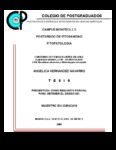Contenido de fenoles libres en chile (Capsicum annum L.) CM-334 inoculado con Nacobbus aberrans y Meloidogyne incognita
Abstract
Con la finalidad de contribuir al entendimiento del fenómeno de rompimiento de resistencia por nemátodos fitoparásitos, en el presente estudio se comparó el contenido de ácidos fenólicos libres en plantas inoculadas y no inoculadas con Nacobbus aberrans o Meloidogyne incognita. Plantas de chile CM-334 resistentes a Phytophtora capsici y M. incognita, pero susceptible a N. aberrans, y plantas de la var J. E. Parker, susceptibles a los tres patógenos, fueron o no inoculadas con 10,000 J2 de M. incognita o N. aberrans. La determinación de los fenoles se realizó mediante espectrofotometría a los 5 días posteriores a la inoculación con los nemátodos. El contenido de fenoles libres en raíces (6.0%) y follaje (21.7%) de plantas resistentes fue significativamente mayor en comparación con las susceptibles. Asimismo, el contenido fue significativamente más alto (68.7% y 78%, respectivamente) en ambos estratos de aquellas plantas que fueron inoculadas con los nemátodos en comparación con las no inoculadas. M. incognita se asoció con una mayor acumulación de ácidos fenólicos en raíces (8.8%) y follaje (15.1%), en comparación con plantas inoculadas con N. aberrans. El contenido de fenoles en raíces y follaje se incrementó significativamente cuando las plantas fueron inoculadas con M. incognita en comparación con las inoculadas con N. aberrans (2.7% y 12%, y 15.4% y 18.9%, en resistentes y susceptibles, respectivamente); aunque, en la resistente sólo el incremento en follaje fue significativo._________With the purpose of contributing to the understanding of the phenomenon of breaking of resistance by plant parasitic nematodes, in the present study the free phenolic acids content in plants inoculated and not inoculated with Nacobbus aberrans or Meloidogyne incognita was compared. Chilli plants of CM-334 resistant to Phytophtora capsici and M. incognita but susceptible to N. aberrans and plants of the cv J. A. Parker, susceptible to the three pathogens, were or not inoculated with 10,000 J2 of M. incognita or N. aberrans. The determination of phenols was made by spectrophotometry 5 days after nematode inoculation. The content of free phenols in roots (6.0%) and foliage (21.7%) of resistant plants was significantly greater in comparison with the susceptible ones. Also, the content was significantly higher (68.7% and 78%, respectively) in both strata of those plants which were inoculated with the nematode in comparison with the non inoculated ones. M. incognita was associated with a greater accumulation of phenolic acids in roots (8.8%) and foliage (15.1%), in comparison with plants inoculated with N. aberrans. The content of phenols in roots and foliage was increased significantly when the plants were inoculated with M. incognita in comparison with those inoculated with N. aberrans (2.7% and 12%, and 15.4% and 18.9%, in resistant and susceptible plants, respectively); although, in the resistant plants only the increase in foliage was significant.
Collections
- Tesis MC, MT, MP y DC [221]


